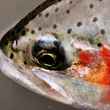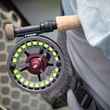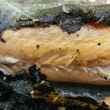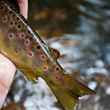To be honest, I wasn’t sure what to expect when my local Hardy rep loaned me Hardy’s new glass-graphite hybrid. I’ve thrown my fair share of Hardy rods — the Zenith was incredible — but have typically found them to be a bit too fast to serve as a go-to rod for the type of Rocky Mountain small-stream fishing I spend most of my time doing.
So, when I picked up the 7’6” 4/5wt Sirrus Glass and gave it the old fly shop wiggle, its liveliness, light weight and soft touch surprised me. When I stepped out for a test cast, well, I just didn’t expect it to be that slow. But it is, and for glass aficionados, that’s a good thing.
The rod loads deep in the blank, nearly to the cork, and shoots line with ease. One stripping guide and hard chrome snakes are wrapped on a light brown, almost golden marshmallow colored, blank.
The blank itself is a great step forward, in my opinion. It features spigot ferrules, which is a great touch both aesthetically and functionally. I’m a firm believer that spigot-ferrule rods cast better than sleeve-ferruled rods.
The use of graphite and glass fibers woven together is far and away the most unique aspect of this rod. Hardy’s rod designers added graphite to the Sirrus Glass in order to give it a crisper action and stronger backbone. While only 10% of the blank is graphite, its efficacy in creating a glass rod with more torsional stability is profoundly evident when casting the Sirrus Glass alongside other rods like the new Fenwick Fenglass or the Orvis Superfine Glass series.
The Sirrus Glass is a very competent rod, and certainly one of my favorite glass rods released in recent years.
What Works
The Action
My collection of fly rods features more classic graphite and bamboo than anything else. Slower three and four weight rods have become my go-to for fishing here in the Rockies, and the Sirrus Glass certainly could carve a spot out for itself in my quiver.
The blank loads very deep, but the addition of graphite alleviates the wobbly feeling most people associate with fiberglass rods.
If you spend your time fishing at 20-35 feet for smaller fish on spring creeks in the high country, only a handful of other rods in the $400 price range can match or exceed what the Sirrus Glass offers.
I fished this rod primarily with a Scientific Anglers Heritage Ultra Presentation WF4F line, which is true-to-weight, and didn’t have any problems getting the rod to launch longer casts. I’d feel confident fishing this 7’6” 4/5wt model on beaver dams, slow moving rivers, and even bigger waters if I had to.
The Graphite
It’s been mentioned a few times now, but I feel it’s so unique it deserves its own section.
Hardy’s use of graphite in the Sirrus Glass rod is a slick move from their rod designers. I know a ton of anglers who don’t like any of my glass rods (antique and new) because they, “act like noodles.”
Infusing Sintrix technology and graphite into the glass blank mitigates that issue. It doesn’t solve it, but a competent caster will enjoy the added torsional stability the graphite provides.
The graphite also cuts down on the weight of the Sirrus Glass. Glass is heavier than graphite. Unsurprisingly, the Sirrus Glass felt lighter in my hand than most glass rods I’ve thrown lately.
Overall Build Quality
Hardy’s workmanship is, as usual, top notch. Yes, the S-glass blank is made in Korea; however, the wrapping and finishing is done here in the United States. Hardy infuses their Sintrix technology (only available in their Korean factory, according to my Hardy rep) in the Sirrus Glass blanks, along with graphite.
The cork was a higher grade than I expected — seeing as the Sirrus Glass will retail for $399 upon its September 12th release — wraps are tight and close together, and the rod’s rich maple burl complements the gunmetal butt cap and sliding downlocking band.

The rod’s spigot ferrules, aside from looking better (in my opinion), add a level of refinement to the Sirrus Glass. Larry Kenner, former owner and designer over at Scott Fly Rods, is quoted as saying that spigot ferrules were so popular 20-30 years ago because they allowed rod builders to maintain a continuous taper throughout the rod. Sleeve ferrules, especially on older graphite rods, had to flare quite a bit to fit over the lower section, which lead to a bump in the taper of the fly rod and a decrease in its efficacy as a casting tool. However, as advances were made in graphite rod design, the sleeve-over ferrule issue was addressed and is now widely used because it provides a faster, stiffer action for rods.
What Doesn’t Work
Lack of Long-Range Accuracy
It's hard to criticize a rod for failing to do something it isn't designed to do, so noting that the Sirrus Glass lacks long range accuracy is more of a warning to uninformed buyers rather than an outing of one of the rod's shortcomings. I did throw a half-weight heavy WF5F line with this rod, but the backbone is still a bit too soft to be launching accurate casts over 60 feet. The rod can cast a whole fly line — any rod can, really — but accuracy at the longest distances wasn't great. But again, this isn’t a rod with which you should be trying to cast an entire fly line. That’s not what it’s made for.
Reel Seat
I’m normally a fan of downlocking reel seats. They look great, have a classic styling, and create a more balanced fulcrum by placing all the weight of the reel and hardware at the end of the blank.
However, there’s a reason so few rods these days still employ sliding bands on their reel seats. Even when matched with a Hardy Duchess 4/5/6, the sliding downlocking band on this reel seat came loose a few times, and exposed the foot of the reel in addition to part of the maple burl insert.
This might not be a deal-breaker for some people, but I don’t like my more expensive reels being exposed to damage – especially the reel foot.
Final Word
Hardy’s new Sirrus Glass rod, like virtually all glass rods, isn’t an all-around rod you can use for nymphing, streamers, and every other rig you can dream up. This is a rod geared most intently towards dry fly, dry-dropper and wet fly rigs. In close, the Sirrus Glass has uncanny accuracy and delicacy with dries, making it ideally suited for the small-stream angler.
All-in-all, Hardy has made a fabulous rod at a reasonable price. If you’re a fan of glass, a dry-fly enthusiast or an angler who spends most of his or her time fishing at shorter distances, this rod is a serious contender for the top spot in the $400 price range.






























Comments
Victor Mikhaylov replied on Permalink
Thanks, this is probably the first review of this rod.
I'm considering it as "to go" rod for targeting small streams , but I also think about Redington Butter stick or Orvis Superfine glass series. Did you have a chance to compare Sirrus with them?
Chris Carter replied on Permalink
I've just bought the 7' #3/4 Sirrus here in the UK and was really surprised to find it says made in China on it! I know Hardy are starting to move production of the classic reels back to England and that all their performance rod ranges have recently been made in Korea but China is a bit of a shock. Are you sure these rods you are getting are finished in the US? I can't see them making blanks in Korea and then shipping them to China or US. The outer cardboard tube it shipped in now has Pure Fishing on it with no mention of Hardy until you see the rod tube. Another backward step for the Hardy brand! I do hope they move more production back to England but it seems Pure Fishing have other ideas right now.
DJ replied on Permalink
It absolutely pains me to say this but i have a Hardy Sirrus Sintrix rod and recently comparing it to my Aventik S glass the Aventik is better built (the reel stays on he cork hasn't got filler, rod case is transportable) casts about the same. Aventik is more compact !
Hardy Sirrus Glass 3pc: 350 pounds sterling
Aventik Super Fiber Glass 4pc (Ebay) : 56 pounds sterling.
Ever since Pure Fishing took over Hardy has taken it's eye of the detail.
It's a quality not quantity!
O and both are made in CHINA !!!
Good luck Hardy.
Pages